2017年帕金森病十大研究进展
帕金森病临床药物治疗研究进展

6 5岁开 始发 病 , 病 率随 年龄 增 长而 逐 渐增 加 ,0岁 发 病率 发 6
约 为 1 。7 % ,0岁 发病 率 达 3 ~ % 。我 国 目前 大 概 有 1 0多 ‰ 5。 7
知 功能 . 有 安全 性 , 对运 动 障碍 的改善 有 一定 帮 助 。 具 且 孙利 等闱 选择 收 治 住 院 的 帕金 森病 患 者 , 其 随机 分 为 治 疗组 和 将 对 照组 , 疗 组 给予 氟 西 汀治 疗 , 照组 不 使 用 任 何 抗 抑郁 治 对
帕金 森 病 ( akno dsae P 是 一 种 以黑 质 纹状 体 P risnS i s .D) e
通路 的退 变为 主要 特 征 的神 经 系统 退 行性 疾 病 。 般 在 5 ~ 一 0
5mg 对 照组 行 常规 治疗 。治 疗 组 1 、4周后 MMS , 22 E改 善 明 显 ,对 照组 治 疗 4 1 、 2周 后 MMS U DR 1 均无 明显 改善 。 E、 P S1 I 两组 均 无 明显不 良反应 。 明美 金 刚可 改善 帕金 森 病患 者认 证
研 究 进 展
21 9 第8 第5 0年 月 1 2 1 卷 期
帕金森病 临床药物治疗研究进展
文 晓 丹
山东 大学 医学 院 2 0 0 7级 临 床 医学专 业 , 山东济 南
2 00 5 02
【 要】 摘 帕金 森 病 (a i o ds s,D 是一 种 常见 的 中老年 神经 系 统变性 疾 病 , 患病 率 随年 龄增 长 而增 加 。P Pr n nS i aeP ) ks e 其 D 治 疗需 要 采取 综合 措 施 , 物治 疗仍 然是 目前临 床 常用 的主 要治疗 手 段 。西药 治 疗 可 以明显 改善 症状 ; 药 中药 治疗 可 以提 高全 身机 能 , 缓病 情进 展 ; 延 中西 药联 合应 用 , 仅提 高 临床疗 效 , 不 而且 大 大降低 西 药 的用量 和副 作用 。 【 词】 关键 帕金 森病 ; 药物 治 疗 ; 究进展 ; 研 综述 【 中图分 类号 】 7 25 R4. 【 标识 码】A 文献 【 章编 号】 17 - 7 12 1 )9 a - 1 - 3 文 6 4 4 2 (0 0 ( )0 8 0 1
中医药防治帕金森病研究进展
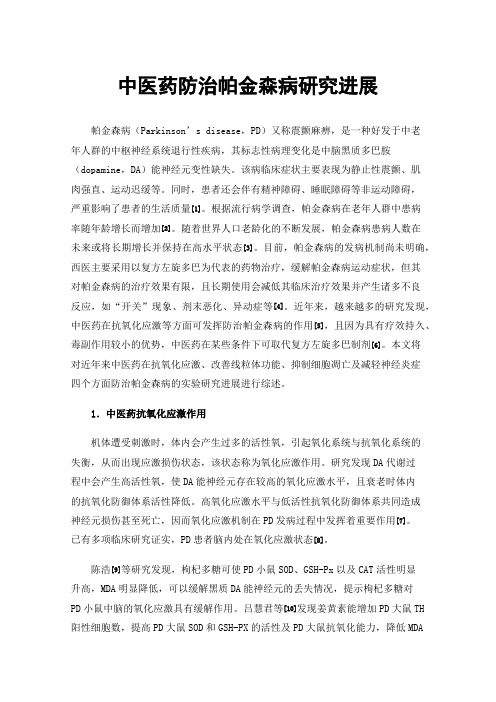
中医药防治帕金森病研究进展帕金森病(Parkinson’s disease,PD)又称震颤麻痹,是一种好发于中老年人群的中枢神经系统退行性疾病,其标志性病理变化是中脑黑质多巴胺(dopamine,DA)能神经元变性缺失。
该病临床症状主要表现为静止性震颤、肌肉强直、运动迟缓等。
同时,患者还会伴有精神障碍、睡眠障碍等非运动障碍,严重影响了患者的生活质量[1]。
根据流行病学调查,帕金森病在老年人群中患病率随年龄增长而增加[2]。
随着世界人口老龄化的不断发展,帕金森病患病人数在未来或将长期增长并保持在高水平状态[3]。
目前,帕金森病的发病机制尚未明确,西医主要采用以复方左旋多巴为代表的药物治疗,缓解帕金森病运动症状,但其对帕金森病的治疗效果有限,且长期使用会减低其临床治疗效果并产生诸多不良反应,如“开关”现象、剂末恶化、异动症等[4]。
近年来,越来越多的研究发现,中医药在抗氧化应激等方面可发挥防治帕金森病的作用[5],且因为具有疗效持久、毒副作用较小的优势,中医药在某些条件下可取代复方左旋多巴制剂[6]。
本文将对近年来中医药在抗氧化应激、改善线粒体功能、抑制细胞凋亡及减轻神经炎症四个方面防治帕金森病的实验研究进展进行综述。
1.中医药抗氧化应激作用机体遭受刺激时,体内会产生过多的活性氧,引起氧化系统与抗氧化系统的失衡,从而出现应激损伤状态,该状态称为氧化应激作用。
研究发现DA代谢过程中会产生高活性氧,使DA能神经元存在较高的氧化应激水平,且衰老时体内的抗氧化防御体系活性降低。
高氧化应激水平与低活性抗氧化防御体系共同造成神经元损伤甚至死亡,因而氧化应激机制在PD发病过程中发挥着重要作用[7]。
已有多项临床研究证实,PD患者脑内处在氧化应激状态[8]。
陈浩[9]等研究发现,枸杞多糖可使PD小鼠SOD、GSH-Px以及CAT活性明显升高,MDA明显降低,可以缓解黑质DA能神经元的丢失情况,提示枸杞多糖对PD小鼠中脑的氧化应激具有缓解作用。
帕金森病的研究进展
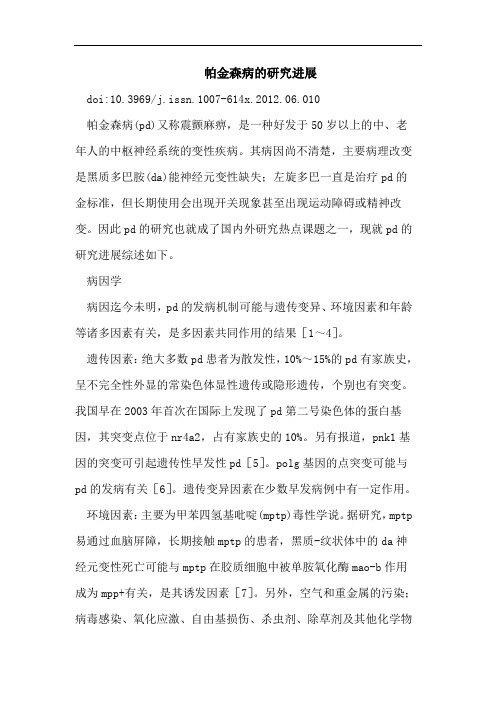
帕金森病的研究进展doi:10.3969/j.issn.1007-614x.2012.06.010帕金森病(pd)又称震颤麻痹,是一种好发于50岁以上的中、老年人的中枢神经系统的变性疾病。
其病因尚不清楚,主要病理改变是黑质多巴胺(da)能神经元变性缺失;左旋多巴一直是治疗pd的金标准,但长期使用会出现开关现象甚至出现运动障碍或精神改变。
因此pd的研究也就成了国内外研究热点课题之一,现就pd的研究进展综述如下。
病因学病因迄今未明,pd的发病机制可能与遗传变异、环境因素和年龄等诸多因素有关,是多因素共同作用的结果[1~4]。
遗传因素:绝大多数pd患者为散发性,10%~15%的pd有家族史,呈不完全性外显的常染色体显性遗传或隐形遗传,个别也有突变。
我国早在2003年首次在国际上发现了pd第二号染色体的蛋白基因,其突变点位于nr4a2,占有家族史的10%。
另有报道,pnk1基因的突变可引起遗传性早发性pd[5]。
polg基因的点突变可能与pd的发病有关[6]。
遗传变异因素在少数早发病例中有一定作用。
环境因素:主要为甲苯四氢基吡啶(mptp)毒性学说。
据研究,mptp 易通过血脑屏障,长期接触mptp的患者,黑质-纹状体中的da神经元变性死亡可能与mptp在胶质细胞中被单胺氧化酶mao-b作用成为mpp+有关,是其诱发因素[7]。
另外,空气和重金属的污染;病毒感染、氧化应激、自由基损伤、杀虫剂、除草剂及其他化学物质的暴露也可增加pd的发生。
散发病例与环境因素有关,尤其在50岁以后更明显。
年龄:年龄是pd发生的重要因素之一,正在60岁以上的老人中以1%的比例发生,且随年龄增长呈上升趋势。
治疗进展pd的治疗目标是减轻症状,延缓进程,提高生存质量。
除常用的药物、手术治疗方法外,还包括锻炼、物理治疗、语言治疗和心理治疗等。
pd的药物治疗包括三个方面:①对症治疗:以减轻症状,恢复功能为主;②保护性治疗:通过干扰神经细胞的死亡,阻止或延缓病情的发展;③修复性治疗:通过神经细胞移植,或通过神经营养因子刺激病变或正常神经元产生较多的多巴胺。
帕金森病综合治疗的研究进展
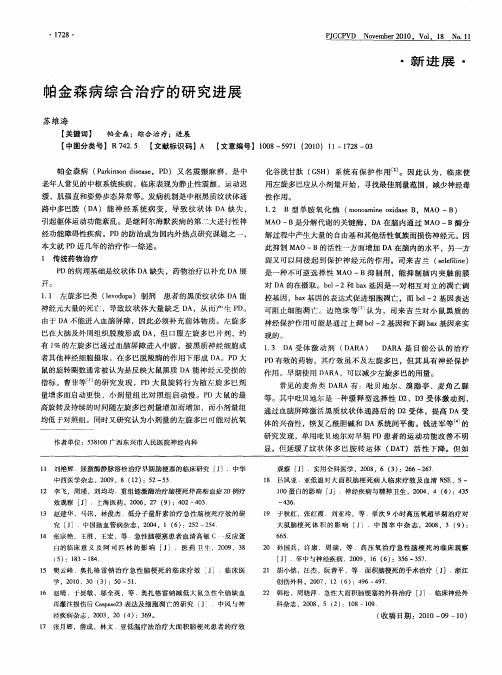
13 D . A受 体 激 动 剂 ( A A) DR
D R 是 目前 公 认 的 治 疗 AA
者其他神经细胞摄取 ,在多巴脱羧酶 的作用下形成 D 。P A D大 鼠的旋转圈数通常被认 为是反映大 鼠黑质 D A能 神经元受损 的 指标 。曹菲等…的研究发现 ,P D大 鼠旋转行 为随左旋 多巴剂 量增 多而启动更快 ,小剂量组 比对照组启 动慢。P D大 鼠的最 高旋转及持续 的时间随左旋多 巴剂量增加而增加 ,而小剂量组 均低 于对照组 。同时又研究认为小剂量的左旋 多巴可能对抗 氧
开。
1 t 左旋多 岜类 (eo oa . 1vdp )制剂
患者 的黑质纹状体 D A能
控基因,bx 因的表达式促进细胞凋亡 ,而 bl 2基 因表达 a基 c一 可阻止细胞凋亡 。边 艳珠 等 认为 ,司来 吉 兰对小 鼠黑 质的 神经保护作用 可能是通过上调 bl 2基因和 下调 bx 因来实 c一 a基
・
l 8・ 72
P C P No e e 01 J C VD v mb r 2 0. Vo . 1 No 1 1 8 . 1
・
新 进 展 ・
帕金 森病 综 合 治 疗 的研 究 进 展
苏维海
【 关键词】 帕金森 ;综合 治疗;进展
【 中国分类号】R725 【 . 4 文献标识码 】 【 A 文章编号 】1 8 57 21 )1 — 78 0 0 — 9 1(00 1 12 — 3 0
1 传 统 药 物治 疗 பைடு நூலகம்
面又可以间接起 到保 护神 经元 的作用 。司来吉 兰 ( e fi ) s e le l n i 是一种不可逆选择性 M O—B抑制剂 ,能抑 制脑 内突触前膜 A
帕金森病合并抑郁症的研究进展

帕金森病合并抑郁症的研究进展帕金森病(Parkinson's disease)是一种慢性进行性疾病,主要症状包括运动障碍、肌肉僵硬和震颤。
除了这些典型的运动症状外,许多患者还会出现抑郁症状。
事实上,帕金森病合并抑郁症是一种常见的并发症,给患者及其家人带来了极大的困扰。
研究帕金森病合并抑郁症的进展,对于改善患者的生活质量至关重要。
本文将对帕金森病合并抑郁症的研究进展进行全面介绍。
一、帕金森病合并抑郁症的临床特征帕金森病合并抑郁症的临床特征主要表现为情感低落、兴趣减退、自卑、自责感、睡眠障碍等。
与单纯的帕金森病相比,合并抑郁症的患者更容易出现认知功能下降、生活质量降低,甚至出现自杀的风险。
早期识别和干预合并抑郁症对于帕金森病患者显得尤为重要。
二、帕金森病合并抑郁症的发病机制关于帕金森病合并抑郁症的发病机制,目前的研究主要集中在多种因素的影响下,包括生理、病理生理、环境和心理社会因素。
生理方面主要包括脑神经系统的变化,特别是多巴胺、5-羟色胺和谷氨酸系统的改变。
病理生理方面,有研究发现帕金森病合并抑郁症患者的海马区和杏仁核等脑部结构发生了改变。
环境因素方面,慢性疾病和药物治疗可能会直接或间接地导致抑郁症的出现。
心理社会因素也在一定程度上促进了合并抑郁症的发生。
三、帕金森病合并抑郁症的治疗进展针对帕金森病合并抑郁症的治疗,目前主要包括药物治疗和非药物治疗两种方式。
药物治疗主要采用抗抑郁药物,如SSRI类药物、三环类药物等。
还可以尝试利用多巴胺促进剂,在改善帕金森病的同时缓解抑郁症状。
非药物治疗包括心理治疗、运动疗法、认知行为疗法等。
针对特定的症状也可以采取相应的干预措施,如失眠、焦虑等。
四、帕金森病合并抑郁症的预防措施对于帕金森病患者,及时干预和预防抑郁症的发生显得至关重要。
健康的生活方式包括规律的作息、饮食均衡、适量的锻炼等对于预防抑郁症的发生具有积极意义。
及时就诊并接受规范的治疗也是预防抑郁症的有效措施。
血尿酸和帕金森病的研究进展
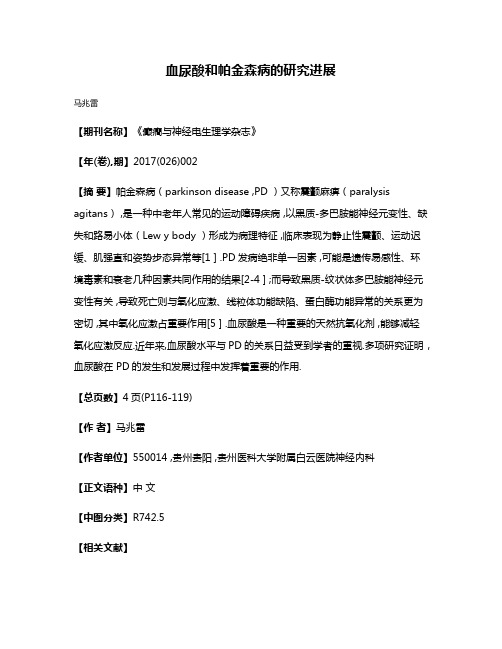
血尿酸和帕金森病的研究进展
马兆雷
【期刊名称】《癫癎与神经电生理学杂志》
【年(卷),期】2017(026)002
【摘要】帕金森病(parkinson disease ,PD )又称震颤麻痹(paralysis agitans) ,是一种中老年人常见的运动障碍疾病 ,以黑质-多巴胺能神经元变性、缺失和路易小体(Lew y body )形成为病理特征 ,临床表现为静止性震颤、运动迟缓、肌强直和姿势步态异常等[1 ] .PD发病绝非单一因素 ,可能是遗传易感性、环境毒素和衰老几种因素共同作用的结果[2-4 ] ;而导致黑质-纹状体多巴胺能神经元变性有关 ,导致死亡则与氧化应激、线粒体功能缺陷、蛋白酶功能异常的关系更为密切 ,其中氧化应激占重要作用[5 ] .血尿酸是一种重要的天然抗氧化剂 ,能够减轻氧化应激反应.近年来,血尿酸水平与PD的关系日益受到学者的重视.多项研究证明 ,血尿酸在 PD的发生和发展过程中发挥着重要的作用.
【总页数】4页(P116-119)
【作者】马兆雷
【作者单位】550014 ,贵州贵阳 ,贵州医科大学附属白云医院神经内科
【正文语种】中文
【中图分类】R742.5
【相关文献】
1.血尿酸和帕金森病的研究进展 [J], 马兆雷;焦玲;
2.血尿酸及血尿酸/肌酐与帕金森病相关性分析 [J], 仲玲玲;宋亚颀;于亮;田向阳;虞颖
3.血尿酸与帕金森病的相关性及其作用机制研究进展 [J], 李晓鹏;赵鹏;钱进
4.血尿酸水平与帕金森病认知障碍的相关性分析 [J], 孔德莲;王华梅;陈校文;吕莹莹;杨婷婷;戎陈月;李圣华
5.血浆同型半胱氨酸、血尿酸在帕金森病中表达水平的研究 [J], 赵丽丽;张硕;陈莹;姜立刚
因版权原因,仅展示原文概要,查看原文内容请购买。
帕金森病治疗研究进展

帕金森病治疗研究进展
单培佳;周颖奇;杨扬;宫峰
【期刊名称】《海军医学杂志》
【年(卷),期】2007(28)4
【摘要】帕金森病(Parkinson disease,PD),又名震颤麻痹,是一种常见的中老年神经系统变性疾病。
其病理特征是中脑黑质纹状体系统多巴胺能神经元的变性死亡,导致脑内多巴胺神经递质减少,出现静止性震颤、肌肉僵直和运动减少等临床表现。
研究报告显示,我国65岁以上PD患病率,男性1.7%,女性1.6%,位居老年神经系统退行性疾病第二位[1]。
本文就PD的治疗研究进展作一介绍。
【总页数】3页(P370-372)
【作者】单培佳;周颖奇;杨扬;宫峰
【作者单位】解放军第四一一医院神经内科,上海,200081;解放军第四一一医院神经内科,上海,200081;解放军第四一一医院神经内科,上海,200081;解放军第四一一医院神经内科,上海,200081
【正文语种】中文
【中图分类】R742.5
【相关文献】
1.针刺治疗帕金森病运动症状临床研究进展 [J], 卢安明;冯玮;袁玉娇;魏嘉琦;林静;王彤;梁军
2.中西医结合治疗帕金森病研究进展 [J], 张双勇;楚海波
3.超声
介导帕金森病治疗研究进展 [J], 郭凯丽;刘亦晨;李昕;王攀
4.磁共振成像技术在帕金森病震颤诊断及脑刺激治疗中的研究进展 [J], 马航;白岩;魏巍;李自强;王梅云
5.褪黑素在帕金森病治疗中的研究进展 [J], 尹亚萍;王宇;田雨阳;马焜;李百祥
因版权原因,仅展示原文概要,查看原文内容请购买。
经颅超声诊断帕金森病的应用研究进展

·综述·帕金森病(Parkinson’s disease,PD)是临床常见的神经变性病,目前我国的患病率和发病率均逐年升高。
1995年Becker等[1]首次描述了经颅超声检查黑质异常高回声(substantia nigra,SN+)与PD之间的联系,开启了评估SN+在PD患者和健康人中临床意义的研究,之后研究[2]证实SN+是PD最重要的危险因素之一。
欧洲神经病学学会联合会认可将经颅超声作为PD诊断及其与帕金森叠加综合征和继发性帕金森综合征鉴别诊断的A级建议[3]。
国内诊断标准也将“经颅超声显示SN+”作为我国PD诊断支持标准中的辅助检查指标[4]。
本文就经颅超声在PD诊断中的应用研究进展进行综述。
一、经颅超声发现PD患者SN+的原理及机制SN+提示黑质纹状体系统神经元变性,动物模型和病理学研究表明PD中SN+可能与铁沉积相关。
Zhu等[5]通过注射6-羟基多巴胺建立PD大鼠模型,经颅超声可观察到大面积SN+,组织病理学检查可见异常回声区铁离子聚集和小胶质细胞增生,铁螯合剂去铁酮灌胃给药后SN+面积缩小,多巴胺能神经元坏死、铁离子蓄积和小胶质细胞增殖均受抑制,认为PD病程中铁聚集和胶质增生均参与SN+的形成。
Yu等[6]通过检测血清和脑脊液中铁及相关蛋白水平,发现SN+组PD患者的血清转铁蛋白、光铁蛋白水平及脑脊液铁水平均较对照组升高,而脑脊液铁蛋白水平降低,差异均有统计学意义(均P<0.05),认为SN+与外周系统向中枢神经系统铁转运增加、细胞内铁释放减少,以及脑内铁沉积过多有关。
一项使用经颅超声和MRI的多模态成像研究[7]使用定量磁化率图在活体内检测出SN+区域脑组织中铁含量增加,大脑中过多的铁沉积可能导致氧化应激和神经炎症,以致神经元退化和死亡。
但并非所有形式的铁含量增加均会导致超声波反射增加,向大鼠黑质内注射载铁蛋白不会导致该区域的高回声,但向大鼠黑质内注射游离铁则会出现高回声改变。
帕金森病发病机制的研究进展
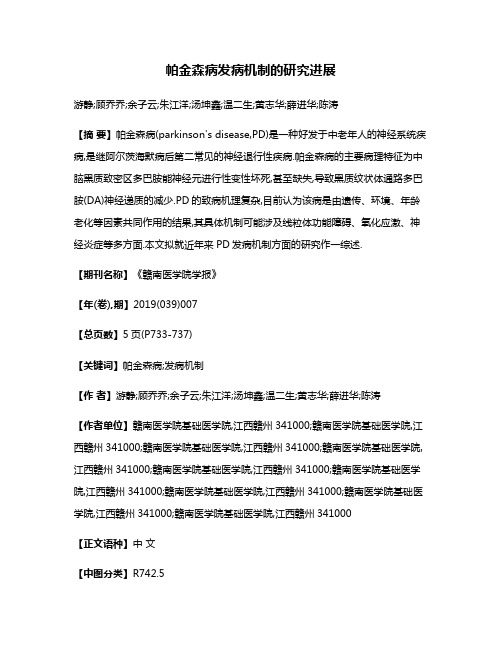
帕金森病发病机制的研究进展游静;顾乔乔;余子云;朱江洋;汤坤鑫;温二生;黄志华;薛进华;陈涛【摘要】帕金森病(parkinson's disease,PD)是一种好发于中老年人的神经系统疾病,是继阿尔茨海默病后第二常见的神经退行性疾病.帕金森病的主要病理特征为中脑黑质致密区多巴胺能神经元进行性变性坏死,甚至缺失,导致黑质纹状体通路多巴胺(DA)神经递质的减少.PD的致病机理复杂,目前认为该病是由遗传、环境、年龄老化等因素共同作用的结果,其具体机制可能涉及线粒体功能障碍、氧化应激、神经炎症等多方面.本文拟就近年来PD发病机制方面的研究作一综述.【期刊名称】《赣南医学院学报》【年(卷),期】2019(039)007【总页数】5页(P733-737)【关键词】帕金森病;发病机制【作者】游静;顾乔乔;余子云;朱江洋;汤坤鑫;温二生;黄志华;薛进华;陈涛【作者单位】赣南医学院基础医学院,江西赣州341000;赣南医学院基础医学院,江西赣州341000;赣南医学院基础医学院,江西赣州341000;赣南医学院基础医学院,江西赣州341000;赣南医学院基础医学院,江西赣州341000;赣南医学院基础医学院,江西赣州341000;赣南医学院基础医学院,江西赣州341000;赣南医学院基础医学院,江西赣州341000;赣南医学院基础医学院,江西赣州341000【正文语种】中文【中图分类】R742.51 概述随着老龄化进程的加速,作为一种常见的老年慢性疾病,帕金森病(parkinson's disease,PD)的发病率正日益增高。
PD临床表现复杂多样,除了运动迟缓、僵化、静止性震颤、姿势不稳等运动功能障碍表现外,还可能合并嗅觉减退、认知功能障碍、情感障碍、睡眠障碍、感觉异常、自主神经功能紊乱等非运动症状。
目前普遍认为,PD的发病率会受年龄、遗传和环境等因素的影响。
其中,高龄是导致PD发病率增加的重要因素。
中医药治疗帕金森病实验性研究进展
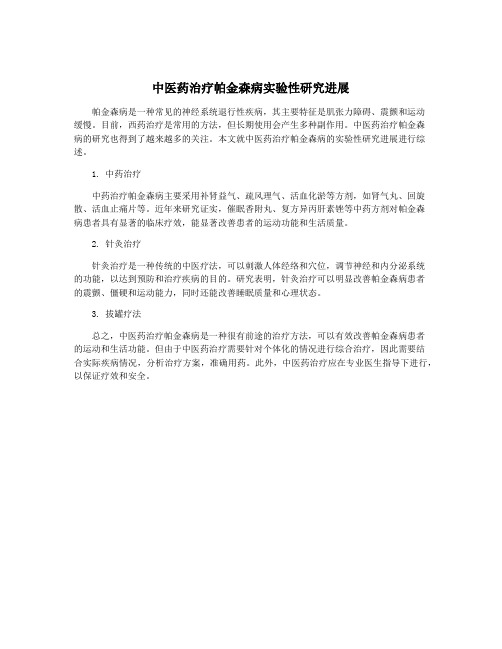
中医药治疗帕金森病实验性研究进展
帕金森病是一种常见的神经系统退行性疾病,其主要特征是肌张力障碍、震颤和运动
缓慢。
目前,西药治疗是常用的方法,但长期使用会产生多种副作用。
中医药治疗帕金森
病的研究也得到了越来越多的关注。
本文就中医药治疗帕金森病的实验性研究进展进行综述。
1. 中药治疗
中药治疗帕金森病主要采用补肾益气、疏风理气、活血化淤等方剂,如肾气丸、回旋散、活血止痛片等。
近年来研究证实,催眠香附丸、复方异丙肝素锉等中药方剂对帕金森
病患者具有显著的临床疗效,能显著改善患者的运动功能和生活质量。
2. 针灸治疗
针灸治疗是一种传统的中医疗法,可以刺激人体经络和穴位,调节神经和内分泌系统
的功能,以达到预防和治疗疾病的目的。
研究表明,针灸治疗可以明显改善帕金森病患者
的震颤、僵硬和运动能力,同时还能改善睡眠质量和心理状态。
3. 拔罐疗法
总之,中医药治疗帕金森病是一种很有前途的治疗方法,可以有效改善帕金森病患者
的运动和生活功能。
但由于中医药治疗需要针对个体化的情况进行综合治疗,因此需要结
合实际疾病情况,分析治疗方案,准确用药。
此外,中医药治疗应在专业医生指导下进行,以保证疗效和安全。
帕金森病的研究报告
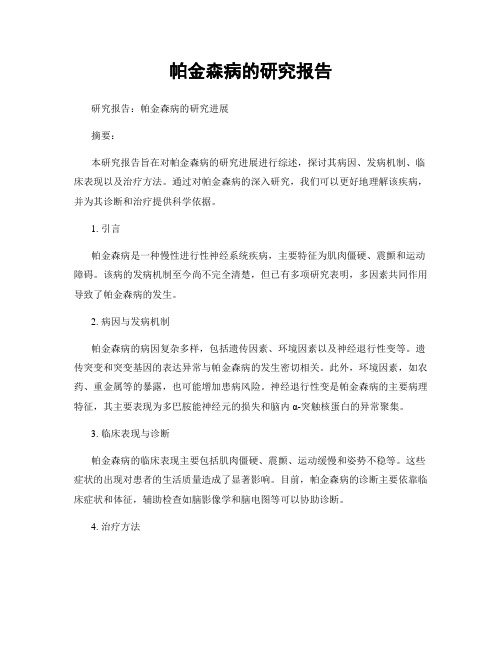
帕金森病的研究报告研究报告:帕金森病的研究进展摘要:本研究报告旨在对帕金森病的研究进展进行综述,探讨其病因、发病机制、临床表现以及治疗方法。
通过对帕金森病的深入研究,我们可以更好地理解该疾病,并为其诊断和治疗提供科学依据。
1. 引言帕金森病是一种慢性进行性神经系统疾病,主要特征为肌肉僵硬、震颤和运动障碍。
该病的发病机制至今尚不完全清楚,但已有多项研究表明,多因素共同作用导致了帕金森病的发生。
2. 病因与发病机制帕金森病的病因复杂多样,包括遗传因素、环境因素以及神经退行性变等。
遗传突变和突变基因的表达异常与帕金森病的发生密切相关。
此外,环境因素,如农药、重金属等的暴露,也可能增加患病风险。
神经退行性变是帕金森病的主要病理特征,其主要表现为多巴胺能神经元的损失和脑内α-突触核蛋白的异常聚集。
3. 临床表现与诊断帕金森病的临床表现主要包括肌肉僵硬、震颤、运动缓慢和姿势不稳等。
这些症状的出现对患者的生活质量造成了显著影响。
目前,帕金森病的诊断主要依靠临床症状和体征,辅助检查如脑影像学和脑电图等可以协助诊断。
4. 治疗方法帕金森病的治疗主要包括药物治疗和手术治疗两种方式。
药物治疗主要通过补充多巴胺或增强其效应来缓解症状。
手术治疗则通过刺激或破坏特定脑区来改善症状。
此外,物理治疗和康复训练也可以有效改善患者的生活质量。
5. 新进展与未来展望近年来,帕金森病的研究取得了一系列重要进展。
新的治疗方法,如基因治疗和干细胞治疗,正在不断探索和发展。
此外,神经保护和修复的研究也成为研究的热点。
未来,我们希望通过进一步的研究,深入了解帕金森病的病因和发病机制,为该疾病的早期诊断和有效治疗提供更多的选择。
结论:帕金森病是一种严重影响患者生活质量的神经系统疾病。
通过对其病因、发病机制、临床表现以及治疗方法的研究,我们可以更好地理解和应对该疾病。
未来的研究将进一步深入探索帕金森病的病理生理过程,为该疾病的早期诊断和治疗提供更多有效的手段。
中医药治疗帕金森病研究进展
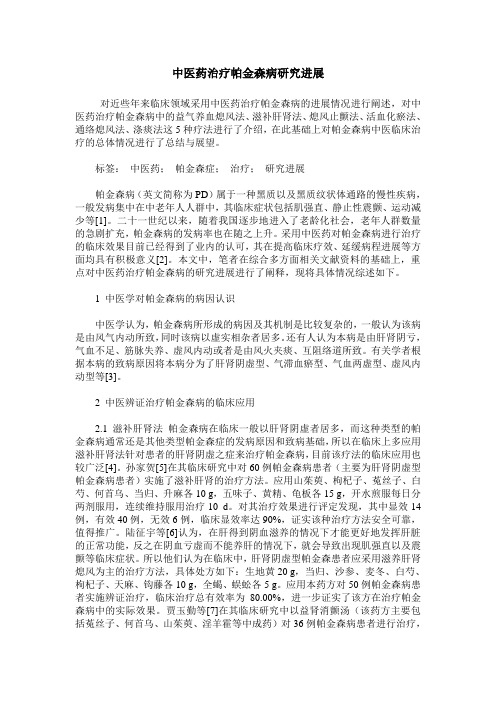
中医药治疗帕金森病研究进展对近些年来临床领域采用中医药治疗帕金森病的进展情况进行阐述,对中医药治疗帕金森病中的益气养血熄风法、滋补肝肾法、熄风止颤法、活血化瘀法、通络熄风法、涤痰法这5种疗法进行了介绍,在此基础上对帕金森病中医临床治疗的总体情况进行了总结与展望。
标签:中医药;帕金森症;治疗;研究进展帕金森病(英文简称为PD)属于一种黑质以及黑质纹状体通路的慢性疾病,一般发病集中在中老年人人群中,其临床症状包括肌强直、静止性震颤、运动减少等[1]。
二十一世纪以来,随着我国逐步地进入了老龄化社会,老年人群数量的急剧扩充,帕金森病的发病率也在随之上升。
采用中医药对帕金森病进行治疗的临床效果目前已经得到了业内的认可,其在提高临床疗效、延缓病程进展等方面均具有积极意义[2]。
本文中,笔者在综合多方面相关文献资料的基础上,重点对中医药治疗帕金森病的研究进展进行了阐释,现将具体情况综述如下。
1 中医学对帕金森病的病因认识中医学认为,帕金森病所形成的病因及其机制是比较复杂的,一般认为该病是由风气内动所致,同时该病以虚实相杂者居多。
还有人认为本病是由肝肾阴亏,气血不足、筋脉失养、虚风内动或者是由风火夹痰、互阻络道所致。
有关学者根据本病的致病原因将本病分为了肝肾阴虚型、气滞血瘀型、气血两虚型、虚风内动型等[3]。
2 中医辨证治疗帕金森病的临床应用2.1 滋补肝肾法帕金森病在临床一般以肝肾阴虚者居多,而这种类型的帕金森病通常还是其他类型帕金森症的发病原因和致病基础,所以在临床上多应用滋补肝肾法针对患者的肝肾阴虚之症来治疗帕金森病,目前该疗法的临床应用也较广泛[4]。
孙家贺[5]在其临床研究中对60例帕金森病患者(主要为肝肾阴虚型帕金森病患者)实施了滋补肝肾的治疗方法。
应用山茱萸、枸杞子、菟丝子、白芍、何首乌、当归、升麻各10 g,五味子、黄精、龟板各15 g,开水煎服每日分两剂服用,连续维持服用治疗10 d。
对其治疗效果进行评定发现,其中显效14例,有效40例,无效6例,临床显效率达90%,证实该种治疗方法安全可靠,值得推广。
帕金森病药物治疗的研究进展
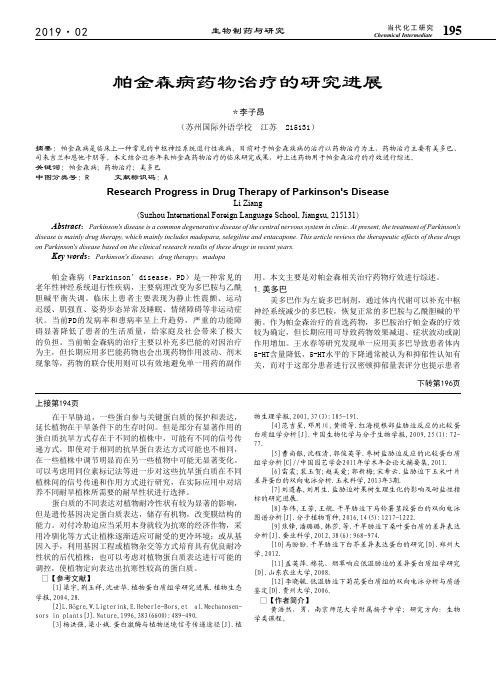
生物制药与研究2019·02195Chenmical Intermediate当代化工研究在干旱胁迫,一些蛋白参与关键蛋白质的保护和表达,延长植物在干旱条件下的生存时间。
但是部分有显著作用的蛋白质抗旱方式存在于不同的植株中,可能有不同的信号传递方式,即使对于相同的抗旱蛋白表达方式可能也不相同,在一些植株中调节明显而在另一些植物中可能无显著变化。
可以考虑用同位素标记法等进一步对这些抗旱蛋白质在不同植株间的信号传递和作用方式进行研究,在实际应用中对培养不同耐旱植株所需要的耐旱性状进行选择。
蛋白质的不同表达对植物耐冷性状有较为显著的影响,但是遗传基因决定蛋白质表达,储存有机物,改变膜结构的能力。
对付冷胁迫应当采用本身就较为抗寒的经济作物,采用冷驯化等方式让植株逐渐适应可耐受的更冷环境;或从基因入手,利用基因工程或植物杂交等方式培育具有优良耐冷性状的后代植株;也可以考虑对植物蛋白质表达进行可能的调控,使植物定向表达出抗寒性较高的蛋白质。
•【参考文献】[1]梁宇,荆玉祥,沈世华.植物蛋白质组学研究进展.植物生态学报,2004,28.[2]L.B ögre,W.Ligterink,E.Heberle-Bors,et al.Mechanosen- sors in plants[J].Nature,1996,383(6600):489-490.[3]杨洪强,梁小娥.蛋白激酶与植物逆境信号传递途径[J].植物生理学报,2001,37(3):185-191.[4]范吉星,邓用川,黄惜等.红海榄根部盐胁迫反应的比较蛋白质组学分析[J].中国生物化学与分子生物学报,2009,25(1):72-77.[5]曹尚银,沈程清,郭俊英等.枣树盐胁迫反应的比较蛋白质组学分析[C]//中国园艺学会2011年学术年会论文摘要集,2011.[6]雷震;裴玉贺;赵美爱;郭新梅;宋希云.盐胁迫下玉米叶片差异蛋白的双向电泳分析.玉米科学,2013年3期.[7]刘遵春,刘用生.盐胁迫对果树生理生化的影响及耐盐性指标的研究进展.[8]李伟,王芳,王舰.干旱胁迫下马铃薯茎段蛋白的双向电泳图谱分析[J].分子植物育种,2016,14(5):1217-1222.[9]焦锋,潘璐璐,韩莎,等.干旱胁迫下桑叶蛋白质的差异表达分析[J].蚕业科学,2012,38(6):968-974.[10]马盼盼.干旱胁迫下白芥差异表达蛋白的研究[D].郑州大学,2012.[11]盖英萍.棉花、烟草响应低温胁迫的差异蛋白质组学研究[D].山东农业大学,2008.[12]李晓毓.低温胁迫下菊花蛋白质组的双向电泳分析与质谱鉴定[D].贵州大学,2006.•【作者简介】黄浩然,男,南京师范大学附属扬子中学;研究方向:生物学类课程。
帕金森病合并抑郁症的研究进展

帕金森病合并抑郁症的研究进展1. 引言1.1 帕金森病合并抑郁症的研究进展帕金森病是一种常见的慢性神经系统退行性疾病,主要症状包括肌张力增高、震颤、运动迟缓等。
随着人口老龄化进程的加快,帕金森病的发病率也在逐渐上升。
研究表明,有相当一部分帕金森病患者会合并出现抑郁症状,严重影响患者的生活质量和治疗效果。
帕金森病合并抑郁症的研究进展已经引起了广泛关注。
神经生物学研究表明,帕金森病与抑郁症之间存在着复杂的神经递质和通路变化。
临床上,帕金森病合并抑郁症的诊断方法和评估标准也逐渐得到了规范化和精细化。
药物治疗和非药物治疗手段在帕金森病合并抑郁症的管理中发挥着重要作用。
预后及管理策略方面,综合性治疗方案的制定对于提高患者的生活质量和延缓疾病进展具有重要意义。
帕金森病合并抑郁症的研究将有望为相关疾病的诊断和治疗提供更多新的思路和方法。
未来的研究方向包括深入探讨神经生物学机制、优化药物和非药物治疗策略,以及建立更科学合理的预后评估和管理方法。
通过不断深入的研究,我们有望为帕金森病合并抑郁症的患者提供更好的医疗服务和关怀。
2. 正文2.1 神经生物学研究神经生物学研究是深入探讨帕金森病合并抑郁症发病机制的重要方面。
通过研究发现,帕金森病患者常常伴随着多巴胺神经元的损伤,导致神经递质的不平衡。
这种神经递质不平衡可能与抑郁症的发生有密切的关系。
在神经生物学的研究中, 研究人员发现抑郁症患者的脑部结构与功能存在明显异常。
杏仁核、杏仁核、杏仁核、杏仁核、杏仁核、杏仁核、杏仁核与杏仁核之间的连通性异常可能导致情绪调节功能失调,从而加重帕金森病患者的抑郁症状。
研究还发现,慢性炎症在帕金森病合并抑郁症的发病机制中扮演着重要角色。
炎症因子的释放可以影响神经元的活动,导致情绪调节失衡,加重抑郁症状。
神经生物学研究揭示了帕金森病合并抑郁症的发病机制,为进一步研究和治疗提供了重要的理论基础。
未来的研究可以继续深入探讨神经递质、脑区连接性和慢性炎症在这一疾病中的作用,以期找到更有效的治疗方法。
帕金森病治疗药物研究进展
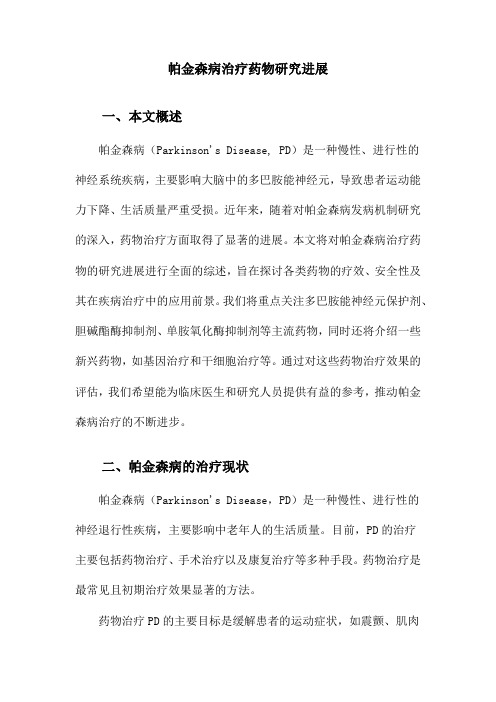
帕金森病治疗药物研究进展一、本文概述帕金森病(Parkinson's Disease, PD)是一种慢性、进行性的神经系统疾病,主要影响大脑中的多巴胺能神经元,导致患者运动能力下降、生活质量严重受损。
近年来,随着对帕金森病发病机制研究的深入,药物治疗方面取得了显著的进展。
本文将对帕金森病治疗药物的研究进展进行全面的综述,旨在探讨各类药物的疗效、安全性及其在疾病治疗中的应用前景。
我们将重点关注多巴胺能神经元保护剂、胆碱酯酶抑制剂、单胺氧化酶抑制剂等主流药物,同时还将介绍一些新兴药物,如基因治疗和干细胞治疗等。
通过对这些药物治疗效果的评估,我们希望能为临床医生和研究人员提供有益的参考,推动帕金森病治疗的不断进步。
二、帕金森病的治疗现状帕金森病(Parkinson's Disease,PD)是一种慢性、进行性的神经退行性疾病,主要影响中老年人的生活质量。
目前,PD的治疗主要包括药物治疗、手术治疗以及康复治疗等多种手段。
药物治疗是最常见且初期治疗效果显著的方法。
药物治疗PD的主要目标是缓解患者的运动症状,如震颤、肌肉僵硬和运动迟缓等,并尽可能延缓疾病的进展。
目前,市场上主要有以下几类药物用于治疗PD:左旋多巴(Levodopa):这是目前治疗PD最有效的药物,能够通过转化为多巴胺来补充大脑中缺失的神经递质,从而改善患者的运动症状。
长期使用左旋多巴可能会引发一系列副作用,如运动波动和异动症等。
多巴胺受体激动剂:这类药物能够模拟多巴胺的作用,激活脑内的多巴胺受体,从而改善患者的运动症状。
常见的多巴胺受体激动剂包括普拉克索和卡麦角林等。
单胺氧化酶抑制剂(MAOIs)和儿茶酚胺-O-甲基转移酶抑制剂(COMT):这两类药物都能够增加大脑中多巴胺的含量,从而改善患者的症状。
由于潜在的副作用和药物间的相互作用,它们通常作为左旋多巴的辅助药物使用。
抗胆碱能药物:这类药物能够减少乙酰胆碱的含量,从而减轻肌肉僵硬和运动迟缓等症状。
帕金森病的神经保护治疗研究进展

多巴胺 能神 经元轴 索的减 少。辅 酶 Q1 0的神 经保 护作 用 归功
于 它 的 抗 细胞 凋 亡 功 能 . 种 功 能 因细 胞 型 和诱 导 细 胞 凋 亡模 这
纳克至 飞克分子就 能起作 用 血一 脑脊液屏 障在很 大程度上 限 制 了它进入 中枢神 经 系统( N ) C S 并在 C S起 作 用。酶 的迅速 N 灭活 , 杂的清除机 制 , 复 潜在 的免疫 原性 , 结合 蛋 白和其他 血、
亚 型 :A 6 G D 5和 G D 7 A 6 ,递 送 到 小 鼠 下 丘 脑 核 。 结 果 发 现 将
G D 5递 送 到 鼠 下 丘 脑 核 不 仅 能使 G B 的 释 放 增 加 , 且 , A 6 AA 而
能 改 变下丘脑 的神 经化 学和 生理性 能进 而使 其信 号输 出从 兴
定 的 神 经 保 护 作 用 i。 s ]
3 神经 营养 因子
神 经 营 养 因子 由能促 进神 经元 生 长发 育 和 ( ) 或 分化 的
蛋 白质 家族 组 成 , 亲 水性 的单 体 或二 聚 体 蛋 白 , 多数分 是 大 子量 为 50 0 3 0 .能促进神 经元的发育 生长和存 活 , 0 00 0 在
后会 出现运 动 障碍 、症状 波动 和精神 障碍等 严重 并发症 。 因
此 . 索 能 阻止 P 进 展 的 药 物 是 必 要 的 。 本 文 将 探 讨 保 护 和 探 D
脑核 .也是 为 了使 信号输 出神 经元 由兴奋性 变成抑 制性 。所
以. 也称该疗 法为病毒性 下丘脑切开术 。 最近 . uig等[用 重组腺 相 关病 毒 (A V) 两种 G D Dr n 7 ] rA 把 A
神经科学帕金森病的最新研究进展
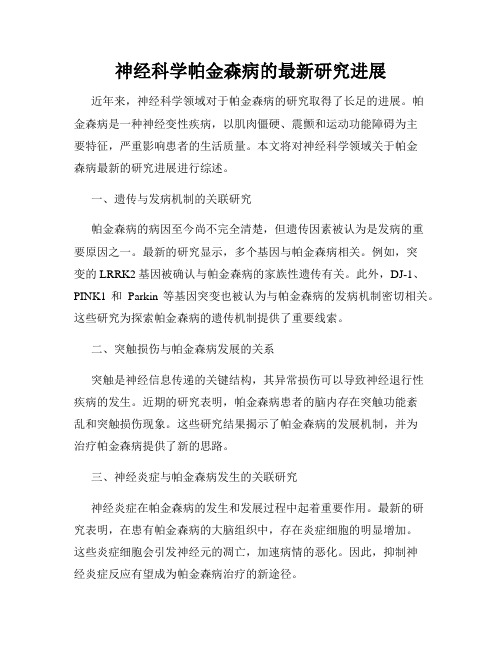
神经科学帕金森病的最新研究进展近年来,神经科学领域对于帕金森病的研究取得了长足的进展。
帕金森病是一种神经变性疾病,以肌肉僵硬、震颤和运动功能障碍为主要特征,严重影响患者的生活质量。
本文将对神经科学领域关于帕金森病最新的研究进展进行综述。
一、遗传与发病机制的关联研究帕金森病的病因至今尚不完全清楚,但遗传因素被认为是发病的重要原因之一。
最新的研究显示,多个基因与帕金森病相关。
例如,突变的LRRK2基因被确认与帕金森病的家族性遗传有关。
此外,DJ-1、PINK1和Parkin等基因突变也被认为与帕金森病的发病机制密切相关。
这些研究为探索帕金森病的遗传机制提供了重要线索。
二、突触损伤与帕金森病发展的关系突触是神经信息传递的关键结构,其异常损伤可以导致神经退行性疾病的发生。
近期的研究表明,帕金森病患者的脑内存在突触功能紊乱和突触损伤现象。
这些研究结果揭示了帕金森病的发展机制,并为治疗帕金森病提供了新的思路。
三、神经炎症与帕金森病发生的关联研究神经炎症在帕金森病的发生和发展过程中起着重要作用。
最新的研究表明,在患有帕金森病的大脑组织中,存在炎症细胞的明显增加。
这些炎症细胞会引发神经元的凋亡,加速病情的恶化。
因此,抑制神经炎症反应有望成为帕金森病治疗的新途径。
四、神经再生与帕金森病治疗的前景神经再生是一种治疗帕金森病的新颖方法。
研究发现,造血干细胞移植具有显著的疗效,可以帮助患者恢复运动功能。
此外,神经干细胞移植和基因治疗等新技术也被用于治疗帕金森病,并取得了一定的成果。
这些研究为帕金森病的治疗提供了新的希望。
五、临床应用与帕金森病研究的结合神经科学与临床研究的结合为帕金森病的治疗提供了实际指导。
随着基因检测和分子影像技术的进步,帕金森病的早期诊断和治疗成为可能。
同时,临床实践中的观察和数据的积累也促进了对帕金森病病理机制的深入理解。
综上所述,神经科学领域对帕金森病的研究取得了显著的进展。
研究人员通过对遗传因素、突触损伤、神经炎症和神经再生等方面的深入研究,不断拓展了对帕金森病发病机制的认识。
丁苯酞配合美多巴治疗帕金森病76例临床研究

丁苯酞配合美多巴治疗帕金森病76例临床研究发表时间:2017-06-27T16:58:30.493Z 来源:《中国误诊学杂志》2017年第5期作者:曾荣[导读] 应用丁苯酞与美多巴联合用药治疗帕金森病效果理想,可有效延缓病情进展,改善患者症状,值得推广。
郴州市第一人民医院中心医院神经内科湖南郴州 423000 摘要:目的:本文就丁苯酞配合美多巴治疗帕金森病的临床效果进行研究与探讨。
方法:选取我院在2015年1月--2016年12月期间收治的76例帕金森病患者,按照随机数字表法分为两个组别,实验组与参照组各38例。
对实验组患者采用丁苯酞配合美多巴治疗,对参照组患者采用美多巴单药治疗,比较两组患者的治疗总有效率及UPDRS评分。
结果:实验组患者的治疗总有效率显著高于参照组,P<0.05;治疗前,两组患者的UPDRS评分无差异,P>0.05,治疗2周、4周后,实验组患者的UPDRS评分均显著优于参照组,P<0.05;所有患者在治疗期间均未出现严重不良反应。
结论:应用丁苯酞与美多巴联合用药治疗帕金森病具有理想果,对改善患者运动、认知功能等均有积极作用,值得推广。
关键词:丁苯酞;美多巴;帕金森病;治疗总有效率帕金森是中老年人的常见病,属于慢性、进展性的锥体外系统功能障碍疾病,患者发病后是以静止性震颤、运动迟缓、认知功能减退等为主要表现[1],对日常生活能力带来一定影响,部分患者还会逐渐丧失自理能力,为家庭及社会带来一定负担。
药物是治疗帕金森患者的有效途径,最为常用的是左旋多巴类药物,但该类患者需长期用药,易产生不良反应,故我院一直为寻求更为理想的药物疗法而努力。
本文对我院近两年收治的部分帕金森患者予以丁苯酞配合美多巴治疗,已取得理想效果;现将研究过程及数据做如下汇报:1 基线资料与方法1.1 基线资料分析此次研究对象均为2015年1月--2016年12月期间我院所收治的帕金森患者,病例数总数为76例;均接受头颅CT或MRI检查,并符合《精神疾病诊断与统计手册诊断标准》[2]中的相关诊断标准被确诊。
帕金森病痴呆相关临床研究进展
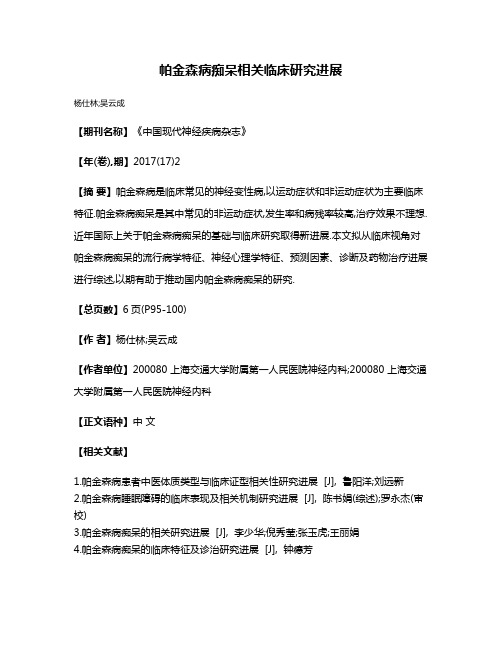
帕金森病痴呆相关临床研究进展
杨仕林;吴云成
【期刊名称】《中国现代神经疾病杂志》
【年(卷),期】2017(17)2
【摘要】帕金森病是临床常见的神经变性病,以运动症状和非运动症状为主要临床特征.帕金森病痴呆是其中常见的非运动症状,发生率和病残率较高,治疗效果不理想.近年国际上关于帕金森病痴呆的基础与临床研究取得新进展.本文拟从临床视角对帕金森病痴呆的流行病学特征、神经心理学特征、预测因素、诊断及药物治疗进展进行综述,以期有助于推动国内帕金森病痴呆的研究.
【总页数】6页(P95-100)
【作者】杨仕林;吴云成
【作者单位】200080 上海交通大学附属第一人民医院神经内科;200080 上海交通大学附属第一人民医院神经内科
【正文语种】中文
【相关文献】
1.帕金森病患者中医体质类型与临床证型相关性研究进展 [J], 鲁阳洋;刘远新
2.帕金森病睡眠障碍的临床表现及相关机制研究进展 [J], 陈书娟(综述);罗永杰(审校)
3.帕金森病痴呆的相关研究进展 [J], 李少华;倪秀莹;张玉虎;王丽娟
4.帕金森病痴呆的临床特征及诊治研究进展 [J], 钟德芳
5.中医药对帕金森病的临床疗效及相关信号通路的研究进展 [J], 张琳婧;梁羽茜;胡秀华;王媛媛
因版权原因,仅展示原文概要,查看原文内容请购买。
- 1、下载文档前请自行甄别文档内容的完整性,平台不提供额外的编辑、内容补充、找答案等附加服务。
- 2、"仅部分预览"的文档,不可在线预览部分如存在完整性等问题,可反馈申请退款(可完整预览的文档不适用该条件!)。
- 3、如文档侵犯您的权益,请联系客服反馈,我们会尽快为您处理(人工客服工作时间:9:00-18:30)。
2017年帕金森病十大研究进展2017年帕金森病十大研究进展第一位:Nature报道α-synuclein可能是引起PD中T细胞免疫异常的关键抗原,提示PD的发生可能与自身免疫机制相关。
Sulzer et al. T cells from patients with Parkinson'sdisease recognizeα-synuclein peptides.Nature. 2017Jun29;546(7660):656-661. AbstractGenetic studies have shown the association of Parkinson'sdisease with alleles ofthe major histocompatibility complex. Here we show that a defined set ofpeptides that are derived from α-synuclein, a protein aggregated in Parkinson'sdisease, act as antigenic epitopes displayed by these alleles and drivehelper and cytotoxic T cell responsesin patients with Parkinson's disease. These responses may explain theassociation of Parkinson's disease withspecific major histocompatibility complex alleles. 第二位:Lancet临床试验证实糖尿病治疗药物Exenatide(GLP-1激动剂)可以用于治疗帕金森病Athauda et al. Exenatide once weekly versus placebo in Parkinson'sdisease: a randomised, double-blind, placebo-controlled trial. Lancet. 2017Oct7;390(10103):1664-1675. AbstractBACKGROUND:Exenatide, a glucagon-like peptide-1(GLP-1) receptor agonist, hasneuroprotective effects in preclinical models of Parkinson'sdisease. We investigated whether these effects would be apparent in aclinicaltrial.METHODS:In this single-centre, randomised,double-blind,placebo-controlled trial, patients with moderate Parkinson'sdisease were randomlyassigned (1:1) to receive subcutaneous injections of exenatide 2 mg or placeboonce weekly for 48 weeks in addition to their regular medication, followed by a12-week washout period. Eligible patients were aged 25-75 years, had idiopathic Parkinson's disease as measured by Queen Square Brain Bankcriteria, were on dopaminergic treatment with wearing-off effects, and were atHoehn and Yahr stage 2·5 or less when on treatment. Randomisation was byweb-based randomisation with a two strata block design according to disease severity. Patients and investigatorswere masked to treatment allocation. The primary outcome was the adjusteddifference in the Movement Disorders Society Unified Parkinson'sDisease Rating Scale(MDS-UPDRS) motor subscale (part 3) in the practically definedoff-medicationstate at 60 weeks. All efficacy analyses were based on a modifiedintention-to-treat principle, which included all patients who completed anypost-randomisation follow-upassessments. The study is registered at(NCT01971242)and iscompleted.FINDINGS:Between June 18, 2014, and March 13, 2015, 62 patients wereenrolled and randomly assigned, 32 to exenatide and 30 to placebo. Our primaryanalysis included 31 patients in the exenatide group and 29 patients in theplacebo group. At 60 weeks, off-medication scores on part 3 of the MDS-UPDRShad improved by 1·0 points (95% CI -2·6 to 0·7) in the exenatide group and worsenedby 2·1 points (-0·6 to 4·8) in the placebo group, an adjusted mean differenceof -3·5 points (-6·7 to -0·3; p=0·0318). Injection site reactions andgastrointestinal symptoms were common adverse events in both groups. Sixserious adverse events occurred in the exenatide group and two in the placebogroup, although none in either group were judged to be related to the studyinterventions.INTERPRETATION:Exenatide had positive effects on practically definedoff-medication motor scores in Parkinson's disease, which were sustained beyond theperiod of exposure. Whether exenatide affects the underlying disease pathophysiology or simply induceslong-lasting symptomatic effects is uncertain. Exenatide represents a major newavenue for investigation in Parkinson's disease, and effects on everydaysymptomsshould be examined in longer-termtrials.FUNDING:Michael J Fox Foundation for Parkinson's Research. 第三位:人类iPSC来源的多巴胺能神经元移植首次在灵长类动物中获得成功。
Kikuchi et al. HumaniPScell-derived dopaminergic neurons function in aprimate Parkinson's disease model.Nature. 2017 Aug30;548(7669):592-596.AbstractInduced pluripotent stem cells (iPS cells) are apromising source for a cell-based therapy to treat Parkinson'sdisease (PD), in which midbrain dopaminergic neurons progressivelydegenerate. However, long-term analysis of human iPS cell-deriveddopaminergic neurons in primate PD models has never been performed to ourknowledge. Here we show that human iPS cell-derived dopaminergicprogenitor cells survived and functioned as midbrain dopaminergic neurons in aprimate model of PD (Macaca fascicularis) treated with the neurotoxin MPTP. Score-basedand video-recording analyses revealed an increase in spontaneous movement ofthe monkeys after transplantation. Histological studies showed that the maturedopaminergic neurons extended dense neurites into the host striatum; thiseffect was consistent regardless of whether the cells were derived frompatients with PD or from healthy individuals. Cells sorted by the floor platemarker CORIN didnot form any tumours in the brains for at least two years.Finally, magnetic resonance imaging and positron emission tomography were usedto monitor the survival, expansion and function of the grafted cells as well asthe immune response in the host brain. Thus, this preclinical study using aprimate model indicates that human iPS cell-derived dopaminergic progenitorsare clinically applicable for the treatment of patients with PD. 第四位:Science研究揭示了多巴胺氧化在耦联线粒体和溶酶体功能障碍中的关键作用,提示氧化应激可能是引起多巴胺能神经元变性的起始步骤。
